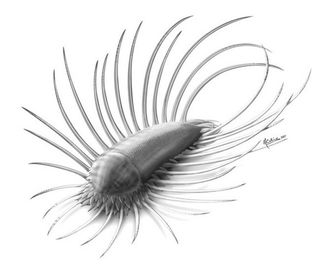Oxygen Brought Earliest Carnivores to Life

Without oxygen, there would be no carnivores. Without carnivores, there would be no Cambrian explosion, the stunning evolutionary burst of diversity in species and body forms that began 540 million years ago.
Those are the findings of a new study that stitches together competing models for why meat-eating appeared simultaneously with the Cambrian explosion. Previously, one camp of scientists had proposed that rising oxygen levels gave animals the extra power to evolve complex body forms. Another school of thought said that competition among animals drove the sudden appearance of new species, such as the weird and wild life forms found in the Burgess Shale, a rock formation in Canada that has been an amazing source of fossils.
"There's always been this tension," said lead author Erik Sperling, a postdoc at Harvard University. "Each side is looking at their own data, which is often common in science."
But Sperling thinks both factors worked in concert to drive the Cambrian explosion, the 20-million-year period when the main branches of the tree of life first appeared. The findings were published July 30 in the journal Proceedings of the National Academy of Sciences.
Sperling and his colleagues looked at modern environments that mimic the conditions of Earth's oceans before the Cambrian explosion. These are low oxygen zones, where oxygen levels are one to 10 percent of typical levels, the same as in the Precambrian. (Geochemical tracers in rocks record a dramatic rise in oxygen in the oceans during the Cambrian explosion. Scientists aren't yet sure of the cause.)
In today's low-oxygen zones, there are few to no carnivores, depending on the amount of available oxygen, Sperling said. "This suggests that in the Precambrian low-oxygen ocean, there were very few carnivores," he said. [Cambrian Creatures: Primitive Sea Life]
Life forms in the lowest-oxygen zones are tiny and microbial, or very small animals similar to the rare fossils recovered from the Precambrian, said study co-author Lisa Levin. "The animals that live there eat detrital material that falls from the surface or are eating bacteria that form on the surface. The biological diversity is very low," said Levin, a biological oceanographer at Scripps Institution of Oceanography in La Jolla, Calif.
Sign up for the Live Science daily newsletter now
Get the world’s most fascinating discoveries delivered straight to your inbox.
But small carnivores ply the transition zones, where oxygen levels start to rise. A similar oxygen boost during the Cambrian fueled the metabolic costs of pursuing prey, the researchers said. The earliest animals first appeared in the fossil record about 200 million years before the Cambrian period, but fossil and molecular evidence indicate meat-eating didn't show up until the Cambrian.
During the Cambrian explosion, animals not only started to eat meat, such as drifting plankton, but they also developed jaws for grabbing and chewing bigger prey. The ensuing arms race led to hard body parts and shells for protection, such as the elaborate spikes and spires of trilobite shells.
Sperling hopes that using the present to understand the past will open new ways to think about the Cambrian explosion. "Looking at modern low-oxygen zones gives us a way to make predictions about whether oxygen is a driver of this event," he told LiveScience. "If an oxygen increase of a certain amount occurred, then this is what we might see."
Email Becky Oskin or follow her @beckyoskin. Follow us @livescience, Facebook & Google+. Original article on LiveScience.com.

Most Popular

